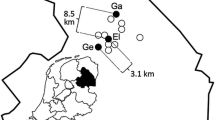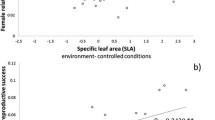Abstract
Pinus densata is distributed on the Tibetan Plateau, where it forms extensive forests at high elevations. Genetic studies have provided evidence that P. densata originated through hybridization between P. yunnanensis and P. tabuliformis. To clarify the relationships among these pines, and assess their reproductive fitness in their respective habitats, we conducted a comparative analysis of eight cone and seed morphometric traits and six reproductive traits in them. Among the eight morphometric traits examined, six appeared to be intermediate in P. densata between those of P. yunnanensis and P. tabuliformis. There were significant differences among the three pines in all of the morphometric traits, and P. densata showed greater variability in these traits than the other two pines. In contrast to the morphometric traits, the reproductive traits (including the proportions of filled and empty seeds, ovule abortion rate, seed efficiency, meiotic abnormalities during microsporogenesis and pollen viability) differed little among the three pines, indicating that they have similar overall rates of effective pollination and fertilization in their respective natural environments. Despite their location on the high plateau, natural populations of P. densata appeared to have normal levels of reproductive success, comparable to those of the two parental species in their natural habitats. This study provides empirical data characterizing the reproductive success and adaptation of a stabilized homoploid hybrid in a novel habitat that is ecologically and spatially inaccessible to its parental species.





Similar content being viewed by others
References
Adamowski ED, Pagliarini MS, Batista LAR (1998) Chromosome elimination in Paspalum subciliatum (Notata group). Sex Plant Reprod 11:272–276
Anderson E, Stebbins GL Jr (1954) Hybridization as an evolutionary stimulus. Evolution 8:378–388
Aparicio A, Albaladejo RG (2003) Microsporogenesis and meiotic abnormalities in the hybrid complex of Phlomis composita (Lamiaceae). Bot J Linn Soc 143:79–85
Arnold ML (1997) Natural hybridization and evolution. Oxford University Press, New York
Arnold ML, Hodges SA (1995) Are natural hybrids fit or unfit relative to their parents? Trends Ecol Evol 10:67–71
Arnold ML, Kentner EK, Johnston JA et al (2001) Natural hybridisation and fitness. Taxon 50:93–104
Atlagic J, Skoric D (1999) Cytogenetic study of Helianthus laevigatus and its F1 and BC1F1 hybrids with cultivated sunflower, Helianthus annuus. Plant Breed 118:555–559
Bingham RT, Squillace AE (1955) Self-compatibility and effects of self-fertility in western white pine. For Sci 1:121–129
Bramlett DL, Popham TW (1971) Model relating unsound seed and embryonic lethal alleles in self-pollinated pines. Silvae Genet 20:192–193
Bramlett DL, Belcher EWJ, DeBarr GL et al (1977) Cone analysis of southern pines: a guidebook. General Technical Report SE-13. Southeastern Forest Exp. Sta., Forest Service, USDA, Asheville, North Carolina
Brooking I (1976) Male Sterility in Sorghum bicolor (L.) Moench induced by low night temperature. I. Timing of the stage of sensitivity. Aust J Plant Physiol 3:589–596
Buerkle CA, Morris RJ, Asmussen MA et al (2000) The likelihood of homoploid hybrid speciation. Heredity 84:441–451
Burke JM, Arnold ML (2001) Genetics and the fitness of hybrids. Annu Rev Genet 35:31–52
Chandler JM, Jan CC, Beard BH (1986) Chromosomal differentiation among the annual Helianthus species. Syst Bot 11:354–371
Dorion S, Lalonde S, Saini HS (1996) Induction of male sterility in wheat by meiotic-stage water deficit is preceded by a decline in invertase activity and changes in carbohydrate metabolism in anthers. Plant Physiol 111:137–145
Duffield JW (1952) Relationships and species hybridization in the genus Pinus. Z Forstgenet Forstpflanzenz 1:93–97
Emms SK, Arnold ML (1997) The effect of habitat on parental and hybrid fitness: transplant experiments with Louisiana irises. Evolution 51:1112–1119
Farris MA, Mitton JB (1984) Population density, outcrossing rate, and heterozygote superiority in ponderosa pine. Evolution 38:1151–1154
Grant V (1966) Selection for vigor and fertility in the progeny of a highly sterile species hybrid in Gilia. Genetics 53:757–775
Grant V (1981) Plant speciation. Columbia University Press, New York
Gross BL, Rieseberg LH (2005) The ecological genetics of homoploid hybrid speciation. J Hered 96:241–252
Guan CT (1981) Fundamental features of the distribution of Coniferae in Sichuan. Acta Phytotaxon Sin 11:393–407 (in Chinese)
Hall BM (1955) Genetic analysis of interspecific hybrids in the genus Bromus, section Ceratochloa. Genetics 40:175–192
Kärkkäinen K, Koski V, Savolainen O (1996) Geographical variation in the inbreeding depression of Scots pine. Evolution 50:111–119
Kirk H, Vrieling K, Klinkhamer PGL (2005) Reproductive fitness of hybrids between Senecio jacobaea and S. aquaticus (Asteraceae). Am J Bot 92:1467–1473
Koski V (1973) On self-pollination, genetic load, and subsequent inbreeding in some conifers. Comm Inst For Fenn 78:1–42
Liu ZL, Zhang D, Hong DY et al (2003) Chromosomal localization of 5S and 18S-5.8S-25S ribosomal DNA sites in five Asian pines using fluorescence in situ hybridization. Theor Appl Genet 106:198–204
Ma XF, Szmidt AE, Wang XR (2006) Genetic structure and evolutionary history of a diploid hybrid pine Pinus densata inferred from the nucleotide variation at seven gene loci. Mol Biol Evol 23:807–816
Matziris D (1998) Genetic variation in cone and seed characteristics in a clonal seed orchard of Aleppo pine grown in Greece. Silvae Genet 47:37–41
McCormick S (1993) Male gametophyte development. Plant Cell 5:1265–1275
Mendenhall W (1967) Introduction to probability and statistics. Wadsworth Publishing Co., Belmont
Miglia KJ, McArthur ED, Moore WS et al (2005) Nine-year reciprocal transplant experiment in the gardens of the basin and mountain big sagebrush (Artemisia tridentata: Asteraceae) hybrid zone of Salt Creek Canyon: the importance of multiple-year tracking of fitness. Biol J Linn Soc 86:213–225
Mosseler A, Major JE, Simpson JD et al (2000) Indicators of population viability in red spruce, Picea rubens. I. Reproductive traits and fecundity. Can J Bot 78:928–940
Owens JN, Simpson SJ, Molder M (1981) Sexual reproduction of Pinus contorta. I. Pollen development, the pollination mechanism and early ovule development. Can J Bot 59:1828–1843
Owens JN, Simpson SJ, Molder M (1982) Sexual reproduction of Pinus contorta. II. Postdormancy ovule, embryo, and seed development. Can J Bot 60:2071–2083
Rajora OP, Mosseler A, Major JE (2000) Indicators of population viability in red spruce, Picea rubens. II. Genetic diversity, population structure, and mating behavior. Can J Bot 78:941–956
Rajora OP, Mosseler A, Major JE (2002) Mating system and reproductive fitness traits of eastern white pine (Pinus strobus) in large, central versus small, isolated, marginal populations. Can J Bot 80:1173–1184
Rieseberg LH (1997) Hybrid origins of plant species. Annu Rev Ecol Syst 28:359–389
Rieseberg LH (2001) Chromosomal rearrangements and speciation. Trends Ecol Evol 16:351–358
Rieseberg LH, Archer MA, Wayne RK (1999) Transgressive segregation, adaptation and speciation. Heredity 83:363–372
Rohlf FJ (1997) NTSYS-pc: numerical taxonomy and multivariate analysis system. Applied Biostatistica Inc., New York
Saini HS (1997) Effects of water stress on male gametophyte development in plants. Sex Plant Reprod 10:67–73
Sarvas R (1962) Investigations on the flowering and seed crop of Pinus sylvestris. Commun Inst For Fenn 53:1–198
Schwarzbach AE, Donovan LA, Rieseberg LH (2001) Transgressive character expression in a hybrid sunflower species. Am J Bot 88:270–277
Singh NB, Chaudhary VK (1993) Variability, heritability and genetic gain in cone and nut characters of Chilgoza pine (Pinus gerardiana Wall.). Silvae Genet 42:61–63
Smith CC, Hamrick JL, Kramer CL (1988) The effect of stand density on frequency of filled seeds and fecundity in lodgepole pine (Pinus contorta Dougl.). Can J For Res 18:453–460
Snyder EB, Clausen KE (1974) Pollen handling. In: Schopmeyer CS (ed) Seeds of woody plants in the United States. Agriculture Handbook no. 450. Forest Service, USDA, Washington, pp 59–88
Sokal RR, Rohlf FJ (1981) Biometry: the principles and practices of statistics in biological research. W.H. Freeman and Company, New York
Song BH, Wang XQ, Wang XR et al (2003) Cytoplasmic composition in Pinus densata and population establishment of the diploid hybrid pine. Mol Ecol 12:2995–3001
Wang XR, Shen XH (1989) Studies on increasing seed production in seed orchards of Pinus tabulaeformis Carr. An analysis of seed losses caused by aborted ovules and empty seeds. J Beijing For Univ 11:60–66 (in Chinese)
Wang XR, Szmidt AE (1994) Hybridization and chloroplast DNA variation in a Pinus species complex from Asia. Evolution 48:1020–1031
Wang XR, Szmidt AE, Savolainen O (2001) Genetic composition and diploid hybrid speciation of a high mountain pine, Pinus densata, native to the Tibetan plateau. Genetics 159:337–346
Wu CL (1956) The taxonomic revision and phytogeographical study of Chinese pines. Acta Phytotaxon Sin 5:131–163 (in Chinese)
Acknowledgements
We thank Dr. Y. J. Liu (Beijing Forestry University), H. Liu and Q. Duo (Tibet University) and S. G. Zhang (Yunnan Yinmore Biotech. Lab.) for their assistance during field work, and Prof. K. X. Xu (Inst. Botany, CAS) for statistical advice. This study was supported by grants from the Natural Science Foundation of China (NSFC 30325006 & 30121003).
Author information
Authors and Affiliations
Corresponding author
Electronic supplementary material
Below is the link to the electronic supplementary material.
Rights and permissions
About this article
Cite this article
Mao, JF., Li, Y. & Wang, XR. Empirical assessment of the reproductive fitness components of the hybrid pine Pinus densata on the Tibetan Plateau. Evol Ecol 23, 447–462 (2009). https://doi.org/10.1007/s10682-008-9244-6
Received:
Accepted:
Published:
Issue Date:
DOI: https://doi.org/10.1007/s10682-008-9244-6




